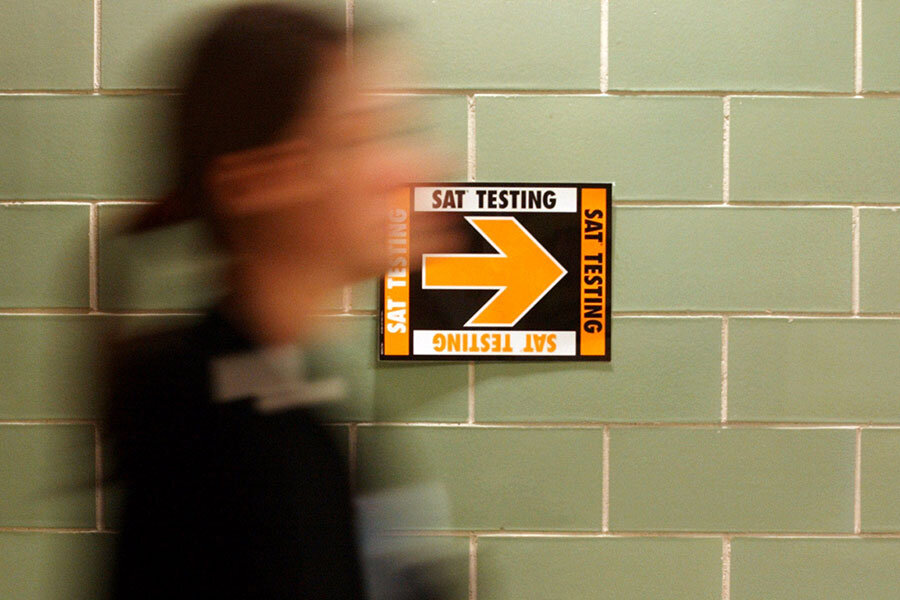As states change use of SAT and ACT, disadvantaged students get boost
Loading...
Minorities and low-income students are getting a boost in college enrollment as more states expand access to SAT and ACT college entrance exams, according to several recent studies.
Traditionally, the SAT or ACT has been administered at testing centers on weekends at a cost of up to $50 – a barrier to disadvantaged students. But as states incorporate the use of SATs and ACTs as a statewide achievement test for high-schoolers, giving them at school and in many cases for free, they remove an important impediment to college eligibility.
At least 14 states now use the tests that way, and by next year the number is expected to top 22. Another handful of states either pay for or require students to take one of the two tests.
“Expanding access is the first step toward expanding opportunity,” said Cyndie Schmeiser, the College Board’s chief of assessment, in a conference call with reporters Aug. 25.
New Hampshire and Connecticut both announced this summer that they’ll be switching to the SAT and away from a test aligned to Common Core standards for 11th-graders. The move is partly driven by the growing anxiety about overtesting.
High school juniors are often loaded up with not only college entrance exams but also Advanced Placement exams, which can lead to college credit. So accountability tests don’t rank high on their priority lists.
There’s long been a “chorus of complaints from school principals and district folks about the lack of effort of 11th-grade kids on tests that have no bearing on their future,” says Scott Marion, associate director of the Center for Assessment in Dover, N.H.
More students may be motivated to do well on college entrance tests because of the potential they hold for admission and scholarships. States hope that they can track achievement gains of all students this way, and help those who may not have considered college to take the first steps.
College-going rates have already seen a boost with statewide entrance testing, several studies have shown.
In Maine, a 2007 mandate for juniors to take the SAT (for free) increased the rate of students attending college by nearly three percentage points – from 48.7 percent to 51.5 percent, according to a study by the College Board, which administers the SAT. Among students who hadn’t been considering college before, it boosted four-year college-going by 10 percentage points.
In 11 states that required and paid for the ACT, four-year college enrollment rose 2 percent, and the effects were larger for poor students (6 percent) and students otherwise unlikely to have taken the test (5 percent), a 2014 University of Connecticut study found.
The gains may not seem large, but “the policy is more cost-effective than traditional student aid at boosting postsecondary attainment,” the UConn study concluded.
ACT reports that in Michigan, which adopted statewide use of the test in 2007, the number of students taking the test went up 59 percent overall – and for African-Americans and Hispanics it went up 83 percent and 114 percent, respectively. Also, for low-income students, the numbers taking the tests more than doubled.
Low-income students in states that don’t provide tests for free can apply for fee waivers. One in 4 SAT test-takers received those this year from the College Board. Once they take that step, they also receive fee waivers to apply to four colleges.
But at a time when many states have been working to better prepare students for future education and jobs, the shift may not be the wisest move, some education observers say.
“The tests measure different things, and if the goal is to measure performance against state standards,” the SAT and ACT don’t do that, says Robert Rothman, senior fellow at the Alliance for Excellent Education in Washington.
For instance, he says, tests aligned with the Common Core expect students to show their writing skills. In the redesigned SAT, the essay portion will be optional.
Since students and teachers tend to focus more on what’s tested, that could just exacerbate the already low level of writing required of high-schoolers, Mr. Rothman says. Thirty-nine percent of high school seniors write one or zero pages a week for English homework, according to a 2011 report by the National Center for Education Statistics.
Critics of standardized tests also say they don’t enhance college access and diversity. There’s a growing list of more than 800 colleges and universities that no longer require the SAT or ACT as part of their application – joined in July by George Washington University.
“The test-optional surge recognizes that no test – not the SAT, old or new, nor the ACT – is needed for high-quality admissions,” said Bob Schaeffer, a spokesman for the National Center for Fair & Open Testing, in a statement.








